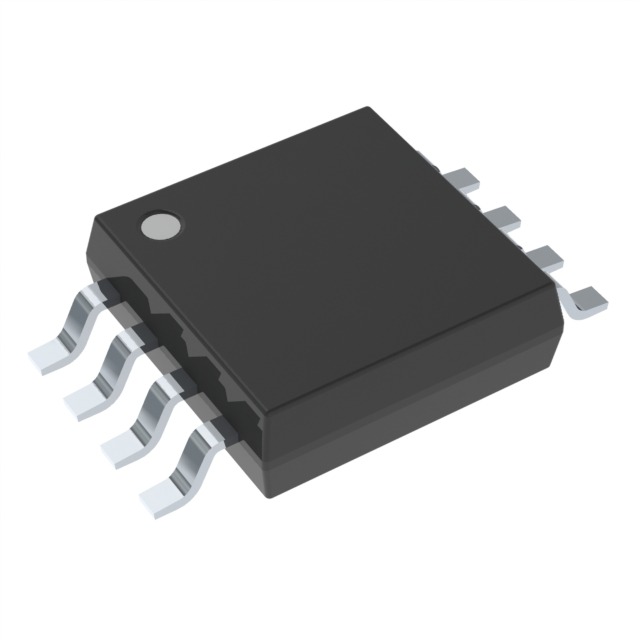DS1371U+T&R
Product Overview
- Category: Integrated Circuit (IC)
- Use: Real-Time Clock (RTC) with I2C interface
- Characteristics:
- Low power consumption
- High accuracy
- Small package size
- Easy integration into various electronic systems
- Package: T&R (Tape and Reel)
- Essence: The DS1371U+T&R is a real-time clock IC designed for accurate timekeeping in electronic devices.
Specifications
- Supply Voltage: 2.3V to 5.5V
- Timekeeping Accuracy: ±2ppm (±0.1728 seconds per day)
- Operating Temperature Range: -40°C to +85°C
- I2C Interface: Supports both standard and fast mode (up to 400kHz)
- Alarm Function: Programmable alarm with interrupt output
- Battery Backup: Integrated trickle charger and power-fail detection circuitry
- Oscillator: On-chip temperature-compensated crystal oscillator (TCXO)
Pin Configuration
The DS1371U+T&R has a total of 8 pins, which are as follows:
- VCC: Power supply input
- GND: Ground connection
- SDA: Serial Data Line for I2C communication
- SCL: Serial Clock Line for I2C communication
- INT/SQW: Interrupt output or Square Wave output selection pin
- X1: Crystal oscillator input
- X2: Crystal oscillator output
- VBAT: Battery backup input for maintaining timekeeping during power loss
Functional Features
- Accurate Timekeeping: The DS1371U+T&R provides precise timekeeping with low power consumption.
- I2C Interface: It supports easy integration into various electronic systems through the widely-used I2C communication protocol.
- Programmable Alarm: Users can set an alarm and configure the interrupt output for specific time-based events.
- Battery Backup: The integrated trickle charger and power-fail detection circuitry ensure uninterrupted timekeeping during power loss.
- Temperature Compensation: The on-chip TCXO compensates for temperature variations, maintaining accurate timekeeping in different environments.
Advantages and Disadvantages
Advantages: - High accuracy - Low power consumption - Easy integration into electronic systems - Programmable alarm feature - Battery backup for uninterrupted timekeeping
Disadvantages: - Limited to I2C interface only - Requires an external crystal oscillator for operation
Working Principles
The DS1371U+T&R utilizes a crystal oscillator to generate precise clock signals. It communicates with the host microcontroller through the I2C interface, allowing the system to read and write time-related information. The integrated battery backup ensures that the clock continues to run even during power loss. The programmable alarm feature allows the user to set specific time-based events, triggering an interrupt output when the alarm condition is met.
Application Field Plans
The DS1371U+T&R finds applications in various electronic devices that require accurate timekeeping. Some potential application fields include:
- Consumer Electronics: Clocks, watches, and digital appliances.
- Industrial Automation: Programmable logic controllers (PLCs), data loggers, and industrial timers.
- Automotive: Dashboard clocks, car audio systems, and navigation devices.
- Medical Devices: Patient monitoring systems, infusion pumps, and medical timers.
- Internet of Things (IoT): Smart home automation, wearable devices, and sensor networks.
Alternative Models
- DS3231: Real-Time Clock IC with I2C interface, higher timekeeping accuracy, and additional features like temperature sensor and alarms.
- PCF8563: I2C Real-Time Clock IC with lower power consumption and integrated alarm function.
- MCP7940N: I2C Real-Time Clock IC with battery backup, programmable alarms, and non-volatile memory for timekeeping data storage.
These alternative models offer similar functionality to the DS1371U+T&R but may have different specifications and package options.
Word count: 520 words
Senaraikan 10 soalan dan jawapan biasa yang berkaitan dengan aplikasi DS1371U+T&R dalam penyelesaian teknikal
Sure! Here are 10 common questions and answers related to the application of DS1371U+T&R in technical solutions:
Q1: What is DS1371U+T&R? A1: DS1371U+T&R is a real-time clock (RTC) module manufactured by Maxim Integrated. It provides accurate timekeeping functionality for various technical applications.
Q2: How does DS1371U+T&R communicate with other devices? A2: DS1371U+T&R communicates using the I2C protocol, which allows it to interface with microcontrollers, sensors, and other devices.
Q3: Can DS1371U+T&R operate on its own without an external microcontroller? A3: Yes, DS1371U+T&R has an integrated oscillator and battery backup, allowing it to function independently without an external microcontroller.
Q4: What is the accuracy of DS1371U+T&R? A4: DS1371U+T&R has a typical accuracy of ±2ppm (parts per million), ensuring precise timekeeping over extended periods.
Q5: Can DS1371U+T&R handle leap years and daylight saving time changes? A5: Yes, DS1371U+T&R supports leap year calculations and can be programmed to account for daylight saving time changes.
Q6: Does DS1371U+T&R have an alarm feature? A6: Yes, DS1371U+T&R includes two programmable alarms that can trigger interrupts or perform specific actions at specified times.
Q7: What is the operating voltage range of DS1371U+T&R? A7: DS1371U+T&R operates within a voltage range of 2.3V to 5.5V, making it compatible with a wide range of power supplies.
Q8: Can DS1371U+T&R be used in battery-powered applications? A8: Yes, DS1371U+T&R has a low-power design and can operate on a backup battery during power outages or when the main power source is disconnected.
Q9: Is DS1371U+T&R suitable for temperature-sensitive applications? A9: Yes, DS1371U+T&R includes a built-in temperature sensor that can be used to compensate for timekeeping inaccuracies caused by temperature variations.
Q10: Are there any development resources available for DS1371U+T&R? A10: Yes, Maxim Integrated provides datasheets, application notes, and example code to help developers integrate DS1371U+T&R into their technical solutions.
Please note that these answers are general and may vary depending on specific implementation details. It's always recommended to refer to the official documentation provided by Maxim Integrated for accurate information.


